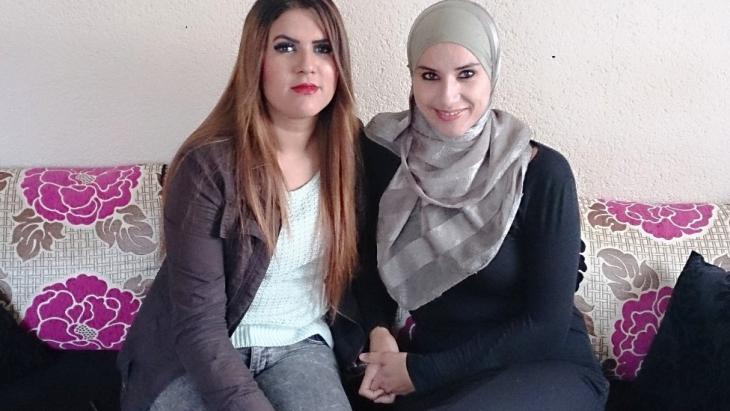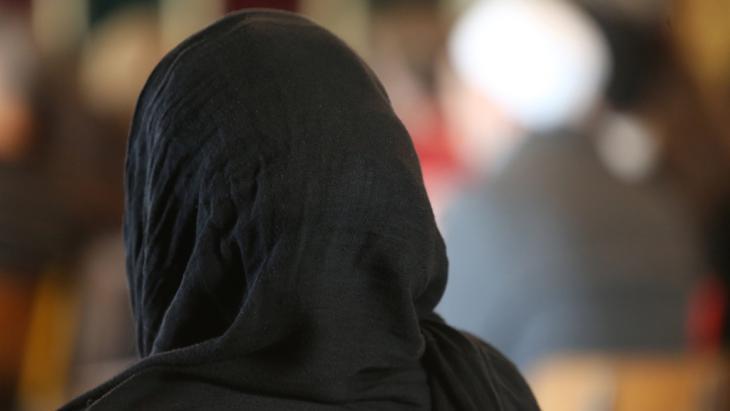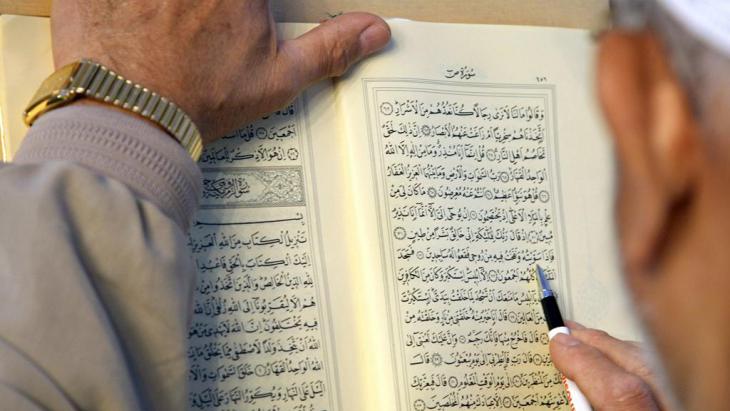No compulsion to wear the headscarf

Rabia Bechari always covers her hair. She likes variety and therefore alternates between black and colourful headscarves. She always chooses clothes that do not cling to the contours of her body. Sometimes she wears a long dress; sometimes she prefers trousers and a tunic.
Rabia Bechari is a devout woman. She prays, fasts and is intensely focused on her religion. She attends lectures and events in which matters concerning Islam are discussed. She also reads books on Islam. As far as Rabia Bechari is concerned, practising one's faith not only means thinking about it, but also being there for others. This is why she works as a volunteer counsellor at a Frankfurt hospital.
Rabia's daughter Nadia is different. Sometimes she wears her hair curled; sometimes straight. She wears tight-fitting clothes and likes to put on flashy makeup. She uses bright red lipstick and wears contact lenses to change the colour of her eyes from dark brown to green.
The joy of provocation
Nadia likes being provocative. That is why she dresses "in a way that girls really shouldn't dress". Nadia knows from her mother that relatives and family friends don't approve of her appearance. "I don't care what people say behind my back," says the 18-year-old in a defiant tone. Rabia Bechari, on the other hand, does care. Nevertheless, she does not comment on her daughter's wardrobe; she believes that pressure is not an effective approach to upbringing.
Mother and daughter live under the same roof. In order to keep the peace, they have come to an unspoken agreement. This also entails Nadia not appearing before her mother in a miniskirt. "It is simply a matter of respect for my mother," says Nadia. When she wants to wear a miniskirt, she just takes it to a friend's house and puts it on there.

In contrast to her daughter, Rabia Bechari has no desire whatsoever to be provocative. Yet despite her intentions, she inadvertently is. Strangers often approach her and ask about her appearance. The 39-year-old mother has become accustomed to inquiries about her religion. She freely enters into conversation and explains her conviction that wearing a headscarf is a religious obligation and an "act of worship".
She is aware of the various interpretations of Islam and, in particular, those concerning the Koran suras dealing with the veiling of female charms. To wear a headscarf without possessing the proper attitude is pure nonsense, says Rabia Bechari. This is why she does not pressure her daughter to wear a headscarf. "You cannot achieve the goal of living a life that is agreeable to God by exerting pressure."
Completely different lifestyles
In terms of their appearance, lifestyle and attitude to life, Rabia and Nadia are completely different. Despite this, mother and daughter respect each other, even though they enjoy "a very complicated relationship". Rabia Bechari says that she values her daughter's "genuine and straightforward manner".
Nadia, in turn, likes the fact that her mother is not willing to take off her headscarf despite the level of opposition it encounters in society. Nadia also finds that her mother looks "very beautiful" with her headscarf. She also likes her mother's conviction that "there is no compulsion in Islam."
Rabia Bechari wasn't always this devout. When she was a child, Rabia asked her mother about religion. Her mother was unable to explain to her the meaning of the precepts and prohibitions in Islam. "She just always told me that she wore a headscarf for religious reasons, but that she didn't know exactly what these reasons were," says Rabia Bechari, who was the second of eight children born to Moroccan parents in Frankfurt, where she grew up.

Choosing the headscarf after divorce
She made the decision to cover her hair around ten years ago, soon after she was divorced from her husband. At the time, she was working as a bank clerk. Her decision was a source of confusion for her colleagues and her former husband, who had failed to convince her to wear a headscarf while they were married.
Since then, Rabia has married and divorced a second time. The single mother of three now works as a childminder and lives in Dreieich near Frankfurt. In addition to her daughter, she also has two sons aged six and seventeen.
"I only became more religious over time and gradually began to learn about Islam," says Rabia Bechari. She did not want her daughter to have a religious upbringing similar to her own, only learning Koran suras by heart, so she sent Nadia to German-language religious courses, some of which were provided by the Pakistani community. "It was all really interesting," says Nadia, although she does not sound too convincing.
Headscarf inappropriate for her lifestyle
For a time, Nadia also wore a headscarf. This was because she thought it made her mother look beautiful. But she didn't only want to wear a headscarf, but make-up as well. Mother and daughter struck a deal. The girl wore a headscarf and was allowed to wear makeup too. At the time, Nadia was 13 years of age and in year 7.
Her teacher did not understand why, from one day to the next, she had begun to wear a headscarf, says Rabia. "She assumed that I had forced my daughter to wear it," adding that anyone who knows Nadia would know that she has a mind of her own and can't be forced to do anything against her will. "I really only wanted to provoke my teacher and my classmates," claims Nadia, looking back on events.
She succeeded in her goal, but it did not do her much good. From this point on, she no longer enjoyed good relations with her teacher. After a few months, when she realised that it "wasn't for her", Nadia stopped wearing the headscarf. Since then, nothing has changed. The headscarf just isn't compatible with her lifestyle, says the 18-year-old. "Maybe there will come a day when I change my mind."
Canan Topcu
© Qantara.de 2014
Translated from the German by John Bergeron